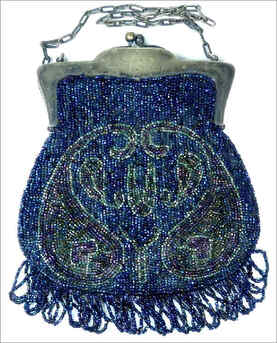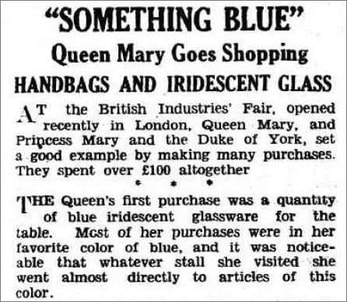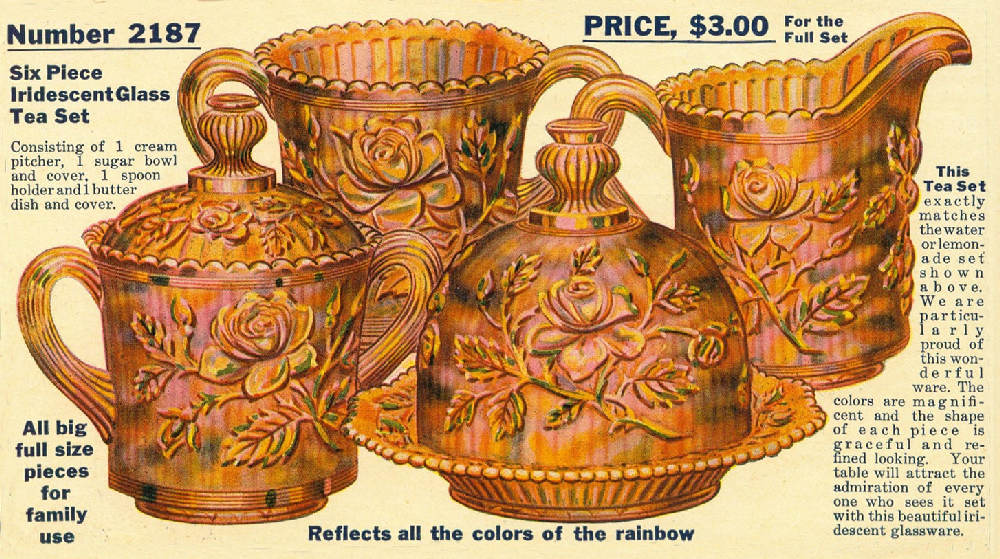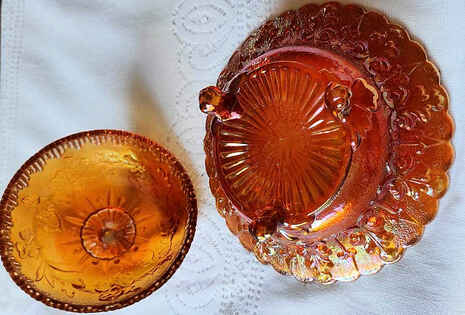NetworK ezine Issue 89. October 2022
Totally Devoted to Carnival Glass
|
Welcome to the October issue of NetworK, in which we begin with a look at Royal connections to Carnival Glass. The recent sad loss of Queen Elizabeth II prompted us to look at those connections, and you might be surprised at the results. If there had been a register of Carnival Glass collectors available to view back in the 1920s and 30s, we’d have surely seen the names of Queen Mary and her daughter, Princess Mary, on the list. Queen Mary was the grandmother of the late Queen Elizabeth II and Princess Mary was her aunt. Newspaper archives from the 1930s confirm that both Queen Mary and her daughter, Princess Mary, were avid collectors of iridescent glass—especially in blue. Details of their lives appeared in the press in Britain, Australia, New Zealand and the USA. From a 1930 edition of the Yorkshire Evening Post (the same article was picked up by the Adelaide Chronicle in Australia), we learn about “Princess Mary’s London Home”—Chesterfield House. The 1930 article explained that “The Princess’s own rooms are decorated throughout in her favourite shade of blue. The Jacobean library is a soft green, and the dining-room has been repapered a rich ivory that excellently sets off its antique furniture. Princess Mary always has a linen cloth on the long table, and frequently a service of iridescent glass.” An iridescent glass table service! Carnival Glass. Further news reports from 1930 also inform us of the Royals purchases at the British Industries Fair – and glassware was at the top of the list. And not just any glassware – it was blue iridescent glassware. From the news reports we learn that “within a minute after entering (the fair) the queen bought a quantity of blue iridescent table glassware”. She was clearly eager to get to the Carnival Glass first, before anyone else – we all know and understand that feeling. What might that iridescent glass have been? As it was at the British Industries Fair, it’s likely it was Sowerby Carnival, although they made little blue. However, assuming Sowerby knew the Royals’ preference for blue, it’s entirely possible that they took along all their blue Carnival items (with their signature “Rainbo” iridescence) in the hope of attracting Royal approval and purchases. Here are some of the possible choices that might have been on offer: |
Above: Royal Carnival Glass collectors. Queen Mary on the left and King George V on the right. In the centre are Princess Mary
and Viscount Lascelles at their wedding in 1922. Above: extract from Pittsburgh Post Gazette 1930.
|
|
Above: Sowerby’s Wickerwork plate and stand (2 pieces) in blue Carnival.
Below, right: Sowerby’s Pineapple sugar in blue. Below, left: Sowerby’s Daisy Block Rowboat in rare aqua blue. It wasn’t just iridescent tableware that attracted the Royals. According to the newspapers, Queen Mary also bought handbags. We wondered if a blue iridescent beaded bag might have caught her eye? |
George VI May Basket – a rare Royal Commemorative
This rare, marigold, handled basket was made to commemorate the coronation of King George VI of the United Kingdom in May 1937 - he was the father of the late Queen Elizabeth II.
This rare, marigold, handled basket was made to commemorate the coronation of King George VI of the United Kingdom in May 1937 - he was the father of the late Queen Elizabeth II.
|
The back-story surrounding King George VI is fascinating, in itself. As he was the second son of King George V, it was his older brother, Edward, who inherited the throne (as Edward VIII) on the death of their father, George V. However, less than a year later Edward abdicated in order to marry Wallis Simpson. So, George VI ascended the throne on his brother’s abdication in December 1936, and his daughter subsequently succeeded him as Queen Elizabeth II in 1952, after George VI’s untimely, early death.
|
Above: two views of the basket viewed from the upper side.
The pattern on the basket is all exterior - but is cleverly executed in reverse so that it can be viewed (and reads correctly) from the top or inside of the basket. The design features a crown in the very centre, and the words CORONATION OF H.M. KING GEORGE VI 1937. Around the lettering are the stylized floral emblems of roses, shamrocks and thistles.
The maker was Matthew Turnbull at the Cornhill Glass Works in Sunderland, England. Our original research back in 2009, proved this when we discovered pages from a 1930s Turnbull catalogue.
|
Two further "Royal" items are worthy of consideration, as they were possibly made to commemorate a Royal event of some kind.
|
Order of the Crown of India vase
(aka Coronation vase aka Imperial Crown vase) This vase is a rare example of Indian Carnival, dating possibly from the 1930s but maybe a little later, and only known in marigold. It is just 5 inches high and has a crimped top. The moulded design features two crowns on opposite sides (straddling the mould seams) with swags or garlands above. With the absence of any lettering, it’s impossible to be certain of the significance of the motifs and emblems on this beautiful vase.
|
Crown of India tumbler This Indian tumbler, standing around 4.5 inches high, is known only in marigold. It was possibly made by Jain c. 1930s or maybe a little later.
The design features a crown motif but there is no commemorative wording, so, as with the Order of the Crown of India vase, it is impossible to be certain of the significance of the motifs and emblems on the item. |
|
Balmoral This item seems especially fitting and poignant: it is the table ware line that was called “Balmoral”. Balmoral is a large royal estate in the beautiful Scottish Highlands – and it was where the late Queen Elizabeth was residing when she passed away in early September (2022). It was considered to be Queen Elizabeth’s favourite summer home. The cachet of this famous royal residence was used by importing agents National Glass Company Ltd (*), to promote a new line of Czech made glassware in the UK in 1930. Naming the line “Balmoral Table Ware – the glass of quality” was a good move, associating it with a superior quality, supposedly fit for royalty. The Balmoral line, known to Carnival collectors as Heavy Vine, was probably made by Rosice in Czechoslovakia (they named it “Lady”). A very wide range of shapes was made, including water pitcher, tumbler, tumble-up, large water bottle, vase, butter dish, cordial and stemmed wine in a variety of sizes, loving cup, plus a very full range of boudoir items, including powder jar, perfume, cologne, ring tree, tray and more. Shown below is a marigold Heavy Vine 8” pedestal footed vase. |
This ad, above right, was in the British Pottery Gazette in July 1930, It was clearly and strongly aimed at the British market, with the triple cachet of a Royal sounding name, a Royal castle, and a British Registered Design number (RD 737581, from 1928).
|
* National Glass Company Ltd. in the UK had no connection with the National Glass Co. of the USA.
There are also many pattern names that have a royal connection of sorts, such as Imperial’s Royalty (OMN Crown) or Indiana’s Revival Windsor. In line with our "royal" theme, Fenton made three different Crown Candle Bowls (using moulds they had acquired from Fostoria) in red Revival Carnival as part of their Christmas 2010 line. Here on the right is one of them - the Luxembourg Crown. Photo courtesy of Burns Auctions. Further Reading Matthew Turnbull - our research in the early 2000s identified that this English maker had made Carnival, including several different baskets. Read all about Turnbull here: Matthew Turnbull Heavy Vine is one of the many patterns we cover in our unique Collectors Facts pages, here: Heavy Vine Fenton Crown Candle Bowls - read the full story: "Crown Candle Bowls" |
To Alice From George
At first glance, this is a familiar piece of Carnival – a Lustre Rose (OMN American Beauty Rose) butter dish in marigold. But ...
At first glance, this is a familiar piece of Carnival – a Lustre Rose (OMN American Beauty Rose) butter dish in marigold. But ...
Photos are courtesy of Emma Martins Bennett.
|
... stop right there, because this is no ordinary piece. Look closely at the base (above, right) and it has an engraving on it, which reads: “Dunedin Exhibition 1925 -26 To Alice From George". So, what’s the back-story to this amazing piece? It was found recently by Emma Martins Bennett in New Zealand - and it had travelled a long way from where it was made by Imperial in the USA! The Dunedin Exhibition was one of the World’s Fairs on the Great Exhibition format. Its full title was the New Zealand and South Seas Exhibition and the first one had been held in Dunedin in 1865. Roll forward 60 years to November 1925 - the Dunedin Exhibition began then and lasted for almost six months into 1926. Exhibitors and traders came from around the world, and it’s estimated that more than three million people visited the show! |
The Dunedin Public Libraries website explains that there were pavilions surrounding a domed Festival Hall, “with walkways and reflective pools and a quarter mile scenic railway”, “an art gallery, amusement area, restaurant, tearooms and a fernery with waterfall and streams”. In recognition of modern progress “the exhibition proved a showcase for electrical power, with its buildings lit up and shining out across the City at night.” (Dunedin Public Libraries).
Naturally, there were souvenirs. If you had visited this massive World’s Fair, you wanted to have something to remind you of your experience – enter Frank Piggott Webb! Frank was from the family of the renowned British glassmaker, Thomas Webb. He was a skilled glass engraver and as a young man, he went to Australia and manned the Thomas Webb & Sons stand at the International Exhibition in Sydney in 1879. There, in the fabulous Garden Palace Exhibition building (constructed to house the 1879 event) Frank demonstrated his glass engraving skills through his penchant for delicate designs featuring foliage and flowers, plus the occasional spider’s web (a play on his last name, of course). In 1887, at the Adelaide Jubilee Exhibition, Frank won an award for his engraved designs. In addition to this, Frank did other, smaller, work. His wife was a skilled embroiderer, and together they would personalise small items for the Exhibition visitors. While she embroidered a customer’s initials in the corner of a handkerchief, Frank would engrave names and dates on small items of glass. Crown Crystal Carnival Glass items are also known with personalised engravings, from the Adelaide Exhibition in 1925.
We know that Frank Webb worked until 1940, so it is possible that he was the one who engraved those as well as the Lustre Rose butter dish shown above.
We know that Frank Webb worked until 1940, so it is possible that he was the one who engraved those as well as the Lustre Rose butter dish shown above.
|
And so, we are left with thoughts of Alice and George, who had attended the Dunedin Exhibition in 1925-6. It’s most likely that they purchased the Lustre Rose butter at the Fair, on one of the stands, and had it engraved on the spot. Perhaps they had considered using it afterwards, on the table, but then decided it was so pretty and was such a perfect reminder of what was surely a magical experience for them both, that they would keep it. Perhaps they put it on a shelf to admire, or even packed it away for safety. And then many years later, along came Emma Martins Bennett who “rescued” it, preserving the fascinating history of this iconic item. Imperial’s rose pattern was introduced around 1911 or 1912. On the right is a table set in a 1916 ad in a Lee Manufacturing catalogue. Although called Open Rose and Lustre Rose, these patterns are part of the same range that was originally called “American Beauties” or “American Beauty Roses” by Imperial. They were extremely popular and were produced in the Classic Carnival era, and reintroduced in Revival Carnival. |
There is even a (rare) look-alike that was made by Riihimaki in Finland! Here is the story of this wonderful Imperial pattern: American Beauties
Beatriz Butter, Esberard, Brazil
Photos of the butter dish are all courtesy of Maria Beatriz de Campos Teixeira Neves Monteiro, and Hélcio Monteiro.
Photos of the butter dish are all courtesy of Maria Beatriz de Campos Teixeira Neves Monteiro, and Hélcio Monteiro.
Beatriz butter dish by Esberard of Brazil.
Our friend, the glass researcher Claudio Deveikis, recently contacted us with news of an exciting new discovery in Brazil. A beautiful butter dish – not seen before – had been found by his friends, collectors Maria Beatriz de Campos Teixeira Neves Monteiro and Hélcio Monteiro. And what makes it even more exciting is that inside the butter are the moulded words ESBERARD RIO.
The butter dish has been named “Beatriz”. The pattern appears to be different on the top and bottom of the dish, and at first, it was felt that maybe two different patterns had been “married” up. The top has flowers and the base has stylised leaves – neither motif is repeated on the other part of the dish.
|
However, Hélcio and Beatriz already had another butter dish in the identical form (flowers on the top and leaves on the bottom), but in green glass, so it seemed that this is how the butter was designed. On the right is the moulded "ESBERARD RIO" mark on the base of the butter. For additional confirmation, on the far right is an extract from Esberard’s 1907 catalogue showing this very same butter, number 307. Grateful thanks to Claudio for letting us know of this amazing new discovery. And thanks to Hélcio and Beatriz for sharing their splendid find and their lovely photos. There is much more on Claudio's blog: Beatriz by Esberard |
|
Spinning Star vase, made by Karhula
Just as we were about to go to press, we were alerted to an exciting, fresh discovery by Tami Curran who has found a Karhula Spinning Star vase in marigold. Previously, this superb vase was known mainly in blue plus the rare iridised milk glass example that Sarian showed us in 2020. However, this marigold version is the first that has been reported to us. Why is this so interesting? Well, Karhula was a little different than other Carnival makers in that they did not make a lot of marigold Carnival. The majority of their iridised glass was in blue. In fact, when we first started researching Karhula in the early 2000s, we were told by glass experts in Finland that Karhula didn’t make marigold at all. However, as we delved further and researched more, we realised that this was not accurate, however, it’s fair to say that more blue Carnival from Karhula is reported, than marigold. Indeed, some patterns are currently only known in blue. Grateful thanks to Tami for her lovely photos and the information. Read about Sarian Stade’s milk glass Spinning Star vase in our NetworK #63 (scroll down the page on our website): NetworK #63 |
Privacy and the use of your information: we only use your name and email address to send you your Carnival Glass NetworK ezine. We will not share your name or email address with anyone else, or use it for any other purpose. You can change your mind about receiving your NetworK ezine at any time by clicking the unsubscribe link at the foot of every issue, or by emailing us at [email protected]
Join us on Facebook
We invite you and your friends to join us all on NetworK's fast growing and very active Facebook Group (link is below), and if you have missed any of the previous issues of NetworK and NetworK Specials, they are all here: Back Issues.
We invite you and your friends to join us all on NetworK's fast growing and very active Facebook Group (link is below), and if you have missed any of the previous issues of NetworK and NetworK Specials, they are all here: Back Issues.



























